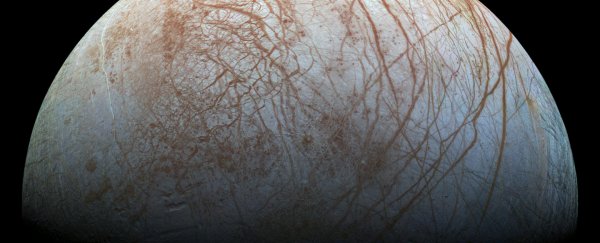During a live stream earlier today, NASA Administrator Charles Bolden outlined the space agency's healthy US$18.5 billion budget for the 2016 financial year - half a billion dollars more than expected.
But what was really exciting about the announcement was that Bolden also explained that US$100 million of that would go towards planning for a mission to Europa - Jupiter's fourth largest moon.
"Looking to the future, we’re planning a mission to explore Jupiter’s fascinating moon Europa."-Bolden#StateOfNASA pic.twitter.com/v9L46zn4Up
— NASA (@NASA) February 2, 2015
The long-awaited news was met with plenty of applause on Twitter, and for good reason - Europa is one of the Solar System's prime candidates for harbouring extraterrestrial life. And yet, up until now, we've paid relatively little attention to the moon.
As one of Jupiter's 63 known satellites, Europa is only a little bit smaller than our own Moon, with a diameter of 3,120 km. But what makes it really compelling to astrobiologists is that, beneath its icy surface lies a huge, liquid ocean, completely covering its rocky core.
As astronomer Phil Plait explained over at his Bad Astronomy blog on Slate in November last year, this water is estimated to be salty, and also around 100 km thick - up to 10 times deeper than Earth's oceans. In fact, telescope observations and data on the moon, gathered by passing spacecraft, suggest that Europa may hold two to three times more liquid water than Earth.
And where there's liquid water, there's often life, which makes it a very tantalising place to explore.
The video below, produced by NASA's Jet Propulsion Laboratory last year explains brilliantly just why the moon is such an exciting prospect.

As the narrator, astrobiologist Kevin Hand, explains, usually Europa's distance from the Sun would mean that all its liquid would be frozen. But because Europa is orbitting Jupiter, it has a strong tidal tug, and all of that energy is converted into mechanical energy. That mechanical energy becomes friction and then heat, which allows the H2O on the moon to stay liquid - not just at the moment, but for much of the history of the Solar System, researchers estimate.
This tidal energy, excitingly, may also cause Europa's ocean to interact with the rocks on the sea floor, astrobiologists predict, and may have triggered hydrothermal vents, which could not just provide the building blocks for life, but also the energy for life.
But until recently, we haven't had the proven robotic technology needed to explore beneath the moon's icy cap. Now, it seems, the time is finally right.
Of course, there's no word yet on exactly what NASA's mission will entail, and with only US$100 million allocated to the project, it seems as though the 2016 fiscal year won't involve much more than planning. But it's still hugely exciting news.
As Plait explained back in November (with freakish foresight):
"I will not be surprised in the least if, for the next fiscal year budget, NASA asks for a Europa mission, including something as dramatic and unprecedented and as some hardware that can penetrate the ice and take a peek into Europa's dark, briny depths … This is something I think NASA should be doing: Pushing the frontier, doing what only a national space agency can do. This would be a huge undertaking, and one that would fire up the public imagination like nothing before it since Apollo."
You can see the full breakdown of NASA's budget here and hear more about their plans in the video below.

Sources: Bad Astronomy, Science Magazine, NASA
